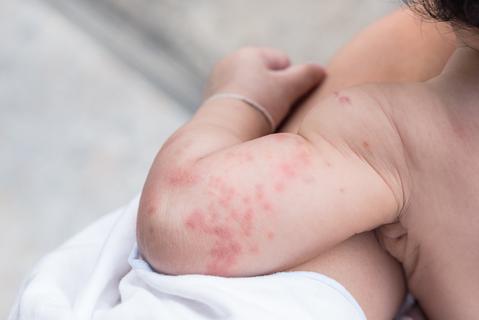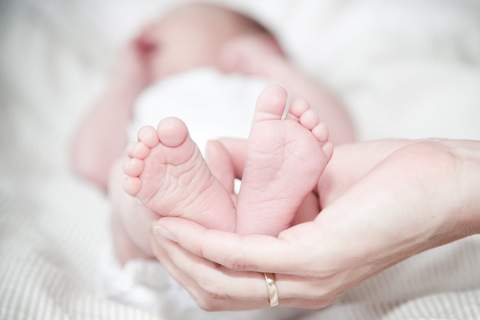by Devishobha (in consultation with her pediatrician)
As a new parent, I had to deal with a ton of unknown problems- child-related, my own health-related, food-related, the list is endless. And, while I was dealing with the sudden surge of emotions and fatigues, I did realize that even and every baby encounters a wave of common health-related issues, such as skin rashes that could leave our little ones in discomfort and parents literally scared.

Rashes occur as an allergic reaction to food, metal, bacteria, smell, dust and could also be due to other factors. I learned that baby rash is probably one of the most common reasons parents consult their pediatricians.
Learning about the common baby rashes can help take the necessary precautions.
Here are 8 of the most common baby rashes:
1. Diaper Rash:
The first few months of a baby’s life revolves around food, sleep, and elimination. Diaper rashes occur due to the constant friction and moisture from a soiled diaper.
Diaper rashes are usually red, slightly raised and spread out from the spot of the rash. Diaper rash is most commonly caused by a yeast Candida albicans and could last for most than a few days. Antibiotics ingested by the mom or the baby can increase the chances of a diaper rash because they help the yeast to grow. In most cases, a diaper rash can be resolved with changes to the diapering routine.
2. Heat Rash:
Heat rashes are commonly caused in skin creases, or in areas that stay in prolonged contact with another surface- like a chair or a car seat, especially in hot, sticky conditions. Heat rash is also sparked through a fever at times. They can be identified by tiny, reddish specks which may be seen turning into small, fluid-filled blisters. The best way to avoid this is to switch to breathable clothing- like soft cotton and avoid contact with rough, heat-inducing surfaces. If it stays on, a pediatrician might suggest corticosteroid cream to help with the rash.
3. Infant Acne:
Infant acne is mostly induced by hormones passed from mother to baby before birth. It is caused by the excess oil produced by the skin glands that tend to clog the pores. Infant acne is identified by whiteheads and pimples on the face and usually clears up without intervention. Washing with harsh soaps or too frequently might aggravate the rashes.
4. Hand Foot and Mouth (HFMD):
Hand-foot-and-mouth disease is caused by a virus called Coxsackievirus and appears with unpleasant symptoms like blisters near the mouth, hands, and fingers accompanied by fever in very young children. The fever disappears after it runs its course, but the rashes could take longer to disappear.
Eat healthy, stay healthy! |
5. Cradle Cap Dermatitis:
Cradle cap is a common inflammatory condition in newborns that appears on the scalp of the baby, identified by yellow, greasy, scaling patches. They typically last for 6-8 months and are generally known to be caused to the still-circulating maternal hormones in the baby. Gently washing the scalp, proper lubrication and avoiding picking on the scales are important to manage the condition.
6. Impetigo:
Impetigo is a condition triggered by the Strep or Staph bacteria and usually occurs as clusters of blisters or red bumps around the nose, mouth or other areas that may ooze fluid or form a brown crust. Your pediatrician would advise treatment involving oral and external antibiotics.
Looking for unique baby girl names? Your search ends here! |
7. Eczema:
Caused by immune cells attacking minor irritants on the body, eczema- also called atopic dermatitis appears as an intensely itchy, inflames, red and scaly rash.
Here’s Dr. Rekha Singh, dermatologist and faculty member of Oliva Skin and Hair Clinic in managing eczema – “Avoid using harsh chemicals on eczema rashes, especially in cold weather as it tends to increase the dryness in the skin. Proper moisturization should be done within 3-5 minutes of a bath so that moisture is locked in the skin. Full clothing is advised to minimize coming in contact with common allergens like dust and pollen.”
8. Erythema Toxicum Neonatorum (ETN):
Often occurring in healthy newborns, ETN is characterized by tiny white or yellow bumps. Once diagnosed by your pediatrician, parents are generally advised that they will resolve on their own without the need for intervention.
Disclaimer:
If you think your child might be contagious, they should stay at home. Keep them away from play areas, playschools, childcare, and other children. You should also keep them away from women who are pregnant, or who might be pregnant since some childhood infections can cause serious problems in unborn babies. Your pediatrician can advise you on treating the symptoms of common rashes. For example, you can use over-the-counter creams to prevent itchiness.


